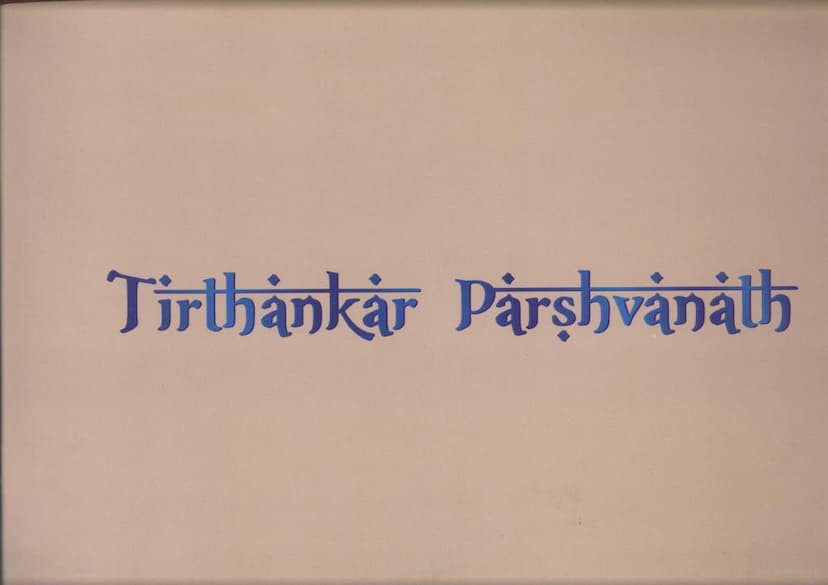Tirthankar Parshvanath
Added to library: September 2, 2025

Summary
This Jain text, "Tirthankar Parshvanath" by Bipin Doshi and Ila Shah, is a comprehensive introduction to the 23rd Tirthankar in Jainism, Lord Parshvanath, and his significance in Jain devotion. Published by Shri Sureshdada Jain and Family, Mumbai, in December 2009, it is dedicated to Matoshri Premabai Jain.
The book highlights that Tirthankaras are liberated souls who guide others to liberation from the cycle of rebirth and suffering. Of the 24 Tirthankaras, Parshvanath is the most widely worshipped, with the largest number of temples and idols. This popularity stems from his previous karmic bonds that made him "beloved of men" (Purisādānīya). While Tirthankaras themselves are free from worldly actions and cannot directly intervene, their attendant deities, Yaksha Parshva and Yakshi Ma Padmavati, are believed to bestow blessings of wealth and health upon their devotees.
A significant portion of the text is dedicated to the Uvassagaharam Stotra and its associated Yantra. This stotra is specifically invoked to destroy calamities and troubles. The book narrates a legend where the stotra was created by Bhadrabahu Swami to alleviate epidemics caused by the revenge of Varahmihir's soul, demonstrating its power to overcome adversity.
The book also focuses on Ma Padmavati Devi, the dedicated deity of Lord Parshvanath. It explains her previous life as a snake queen, Dharanendra and Padmavati, who were saved and enlightened by Parshvanath. Their rebirth in heaven as attendant deities, with rational perception, makes their idols found in some Jain temples. Iconographically, Padmavati is depicted with a snake hood, seated on a lotus, with a golden complexion, and riding a snake with a cock's head. Her worship is described as beneficial for attaining wealth and prosperity.
The text provides the Chintamani Yantra and Parshva Yaksha and Padmavati Yantra, suggesting their daily worship for wealth and prosperity.
Tirthankars in Jainism are explained as souls who achieve liberation and guide others through the "three jewels": right faith, right knowledge, and right conduct. The cyclical nature of time (Utsarpini and Avasarpini eras) and the role of Tirthankaras in each era are discussed. The book clarifies that while Tirthankara worship is primarily for inspiration, it can also generate good karma leading to worldly benefits like wealth and health.
The Previous Bhavas (Lives) of Tirthankar Parshvanath are detailed, beginning with his first life as Marubhuti and his eternal conflict with Kamath. The narrative emphasizes the lessons of letting go of ill-feelings and the power of forgiveness (Kshama) in overcoming anger, a theme that recurs throughout Parshvanath's lives.
The Life of Tirthankar Parshvanath is presented, establishing him as the 23rd Tirthankar and the earliest widely accepted historical figure in Jainism, active in the 9th Century BCE. His birth in Varanasi to King Ashvasen and Queen Vamadevi, and his name "Parshvakumar" derived from the snake seen during his conception, are explained. His marriage to Prabhavati and the circumstances surrounding it, including an encounter with King Yavan, are described.
A significant part of his life story involves his Encounter with Kamath. Parshvanath intervenes when Kamath is performing a violent five-fire penance, revealing the presence of snakes in the sacrificial fire. These snakes, revived by the Namaskar Mahamantra, are reborn as Dharanendra and Padmavati.
The text details Parshvanath's Initiation at the age of 30, where he renounced worldly possessions and became a monk, attaining Manah Paryaya Gnan. His final and most significant encounter with Kamath, who, reborn as Meghmali Dev, attempts to disrupt Parshvanath's deep meditation through supernatural means like floods and storms, is vividly described. The protection provided by Dharanendra and Padmavati, shielding Parshvanath with their hoods, highlights the role of divine attendants. The narrative emphasizes Parshvanath's equanimity and detachment, being neither attached to his protectors nor resentful of his tormentor.
His Liberation is described as attaining Omniscience after 84 days of initiation, becoming Bhagwan Parshvanath, and establishing his four-fold order. He attained Nirvana (liberation) at the age of 100 on Sammetshikhar mountain. The book also describes his iconography, including his representation with a snake hood (often multi-headed), his posture (Padmasana), his blue-black complexion, and the presence of Dharanendra and Padmavati. Many temples are dedicated to him, and he is honored in at least 108 different forms.
The five major events in a Tirthankar's life, known as Kalyanakas (Chyavana, Janma, Diksha, Kevaljnana, and Nirvana), are explained, along with the specific dates for Lord Parshvanath's Kalyanakas.
The book features several prominent Jinalayas (temples) dedicated to Parshvanath, including Shri Shankheswar Parshwanath, Shri Jiravala Parshwanath, Shri Nageshwara Parshwanath, Shri Azahara Parshwanath, Shri Stambhana Parshwanath, Shri Nakoda Parshwanath, Shri Sherisha Parshwanath, Shri Navkhanda Parshwanath, Shri Avanti Parshwanath, Shri Lodrava Parshwanath, Shri Antarikhji Parshwanath, Shri Godiji Parshwanath, Shri Uvassaggaharam Parshvanath, Shri Panchasara Parshwanath, Shri Kalikund Parshvanath, Shri Sahastrafana Parshwanath, and Shri Amizara Parshwanath, each with a unique story and significance.
Mystical Mantras are provided for various purposes, such as gaining wealth and prosperity, having children, warding off thieves, making enemies into friends, achieving political victory, gaining fame, and curing diseases.
The text also includes devotional prayers and invocations: the Namiuna Stotra by Acharya Mantungasuriji, credited with overcoming 108 fears and obstacles, and the Kalyana Mandir Stotra, which recounts Parshvanath's victory over Kamath and emphasizes seeking refuge only in Tirthankaras. The Shri Jirapalli Parshva Stava is also presented as a powerful mantra for overcoming obstacles and achieving desires.
Finally, the book concludes by discussing Jainism as a religion of non-violence, highlighting its core principles such as Ahimsa (non-violence in thought, word, and deed), Anekantvad (multiplicity of views), the theory of Karma (where God does not interfere with consequences), and the belief that all souls have the potential to become Supreme Beings. It emphasizes Jainism as a way of life for physical, mental, social, and spiritual well-being, with the ultimate aim of liberation from the cycle of birth and death. The list of 108 Names of Shri Parshvanath Bhagavan is also provided.